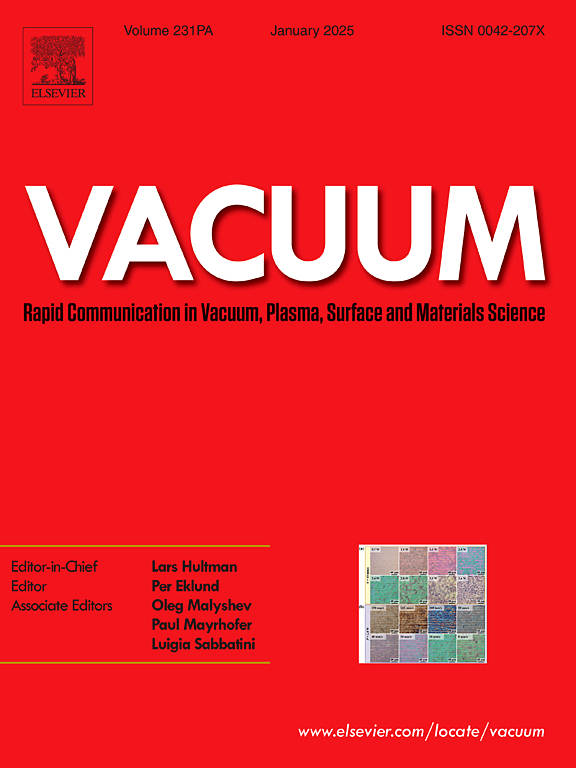铌薄膜脉冲激光沉积过程中的生长速率对蓝宝石 R 平面的影响
IF 3.8
2区 材料科学
Q2 MATERIALS SCIENCE, MULTIDISCIPLINARY
引用次数: 0
摘要
确定了在超高真空中通过脉冲激光沉积在单晶蓝宝石 R 平面上获得高质量铌外延薄膜的最佳条件。室温电阻与残余电阻 (RRR) 与基底温度的比率在约 630 °C 时达到最大值。RRR 与生长速率的关系在生长速率为 3-6 nm/min 时达到最大值。在外延铌薄膜中,RRR 值和相对蓝宝石 R 面的铌(001)生长错向同时增加。在 RRR 最大值时,铌 X 射线衍射(XRD)峰 (002) 和 (011) 的形状是对称的,接近高斯分布;在 RRR 值较低时,XRD 峰的形状变得不对称,不能用单一的高斯分布来近似,其形状可以用多个高斯函数的和来描述。对于所有获得的薄膜,铌(002)和铌(011)峰的半最大全宽(FWHM)分别为 0.2o 和 0.4о。铌(002)摇摆曲线的全宽最大值为 0.4o。本文章由计算机程序翻译,如有差异,请以英文原文为准。
Influence of the growth rate during Nb film pulsed laser deposition on the sapphire R-plane
Optimal conditions for obtaining high quality epitaxial Nb thin films on the monocrystalline sapphire R-plane by pulsed laser deposition in ultrahigh vacuum have been determined. The ratio of room temperature resistance to the residual resistance (RRR) on the substrate temperature has the maximum at about 630 °C. The RRR dependence on the growth rate has the maximum at growth rates of 3–6 nm/min. In epitaxial Nb films, there is a simultaneous increase in the value of RRR and growth misorientation of Nb(001) relatively sapphire R-plane. At the maximum value of RRR, the shapes of Nb X-ray diffraction (XRD) peaks (002) and (011) are symmetrical and close to the Gaussian distribution; at lower RRR values, the shapes of XRD peaks become asymmetrical and cannot be approximated by a single Gaussian distribution, and their shape can be described by the sum of several Gaussian functions. For all obtained films, full width at half maximum (FWHM) of Nb (002) and Nb (011) peaks are 0.2o and 0.4о, respectively. FWHM of Nb (002) rocking curves is 0.4o.
求助全文
通过发布文献求助,成功后即可免费获取论文全文。
去求助
来源期刊

Vacuum
工程技术-材料科学:综合
CiteScore
6.80
自引率
17.50%
发文量
0
审稿时长
34 days
期刊介绍:
Vacuum is an international rapid publications journal with a focus on short communication. All papers are peer-reviewed, with the review process for short communication geared towards very fast turnaround times. The journal also published full research papers, thematic issues and selected papers from leading conferences.
A report in Vacuum should represent a major advance in an area that involves a controlled environment at pressures of one atmosphere or below.
The scope of the journal includes:
1. Vacuum; original developments in vacuum pumping and instrumentation, vacuum measurement, vacuum gas dynamics, gas-surface interactions, surface treatment for UHV applications and low outgassing, vacuum melting, sintering, and vacuum metrology. Technology and solutions for large-scale facilities (e.g., particle accelerators and fusion devices). New instrumentation ( e.g., detectors and electron microscopes).
2. Plasma science; advances in PVD, CVD, plasma-assisted CVD, ion sources, deposition processes and analysis.
3. Surface science; surface engineering, surface chemistry, surface analysis, crystal growth, ion-surface interactions and etching, nanometer-scale processing, surface modification.
4. Materials science; novel functional or structural materials. Metals, ceramics, and polymers. Experiments, simulations, and modelling for understanding structure-property relationships. Thin films and coatings. Nanostructures and ion implantation.
 求助内容:
求助内容: 应助结果提醒方式:
应助结果提醒方式:


